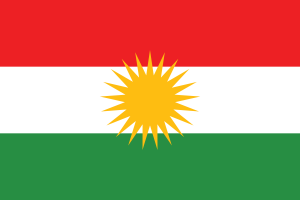Language/Northern-kurdish/Grammar/Past-Tense
| ◀️ Present Tense — Previous Lesson | Next Lesson — Future Tense ▶️ |
Introduction[edit | edit source]
In this lesson, we will explore the past tense in Northern Kurdish. The past tense is used to talk about actions or events that have already happened in the past. It is an essential aspect of the language, as it allows us to express ourselves in various contexts. By the end of this lesson, you will have a solid understanding of how to form and use the past tense in Northern Kurdish.
Formation of the Past Tense[edit | edit source]
To form the past tense in Northern Kurdish, we generally add a specific suffix to the verb stem. The suffixes used for the past tense vary depending on the verb class and tense person. Let's take a look at the different verb classes and their corresponding past tense suffixes:
Verb Class 1[edit | edit source]
Verb class 1 includes verbs that have a single consonant at the end of the verb stem. To form the past tense in verb class 1, we add the suffix "-î" to the verb stem. Here are a few examples:
| Northern Kurdish | Pronunciation | English Translation |
|---|---|---|
| کردن (kirin) | [kiːˈɾin] | to do |
| خوێندن (xwendin) | [xoːˈwənːdɪn] | to read |
| نووسین (nûsîn) | [noːˈwiːsɪn] | to write |
Verb Class 2[edit | edit source]
Verb class 2 includes verbs that have two consonants at the end of the verb stem. To form the past tense in verb class 2, we add the suffix "-a" to the verb stem. Here are a few examples:
| Northern Kurdish | Pronunciation | English Translation |
|---|---|---|
| نێوان (nêwan) | [neːˈwan] | to sit |
| پێشواز (pêşewaz) | [peːˈʃeːwaz] | to dance |
| شکستن (şikandin) | [ʃɪˈkandɪn] | to break |
Verb Class 3[edit | edit source]
Verb class 3 includes verbs that end in a vowel. To form the past tense in verb class 3, we add the suffix "-yî" to the verb stem. Here are a few examples:
| Northern Kurdish | Pronunciation | English Translation |
|---|---|---|
| دەرچوون (derchûn) | [deɾˈt͡ʃʊn] | to go |
| ڕێگەدان (rêgedan) | [ɾeːˈgedan] | to run |
| دەفتەرکردن (defterkirdin) | [deftəɾˈkiɾdɪn] | to study |
Verb Class 4[edit | edit source]
Verb class 4 includes irregular verbs that do not follow the patterns of the previous verb classes. These verbs have unique past tense forms that need to be memorized. Here are a few examples:
| Northern Kurdish | Pronunciation | English Translation |
|---|---|---|
| بوون (bûn) | [bun] | to be |
| دانان (dan) | [dan] | to give |
| ئامادەبوون (amadebûn) | [amadeˈbun] | to prepare |
Usage of the Past Tense[edit | edit source]
The past tense in Northern Kurdish is used to talk about actions or events that have already happened in the past. It is often used to narrate past experiences, describe past actions, or express regrets. Let's take a look at some examples:
- He went to the market yesterday.
- We studied for the exam last night.
- They visited their grandparents last summer.
In Northern Kurdish, the past tense is also used to express hypothetical or unreal situations. For example:
- If I had money, I would travel the world.
- If she knew the truth, she would be upset.
Regional Variations and Cultural Insights[edit | edit source]
Northern Kurdish is spoken in various regions, and there may be slight differences in the usage or understanding of the past tense. Regional variations can be influenced by historical, cultural, or social factors. For example, some dialects may have unique past tense forms or use different suffixes to indicate the past tense. It is important to be aware of these variations and adapt your language accordingly when interacting with different speakers of Northern Kurdish.
Interesting Fact: The Northern Kurdish language belongs to the Indo-European language family and is primarily spoken in the Kurdistan region, which spans across parts of Turkey, Syria, Iran, and Iraq. It is one of the main languages spoken by the Kurdish people, who have a rich cultural heritage and a long history of struggle for recognition and autonomy.
Practice Exercises[edit | edit source]
Now it's time to practice what you've learned! Complete the following exercises by conjugating the verbs in the past tense:
Exercise 1: Conjugate the following verbs in the past tense:
- کڕد (kird) - to do
- خوێند (xwend) - to read
- نووس (nûs) - to write
Solution:
- کڕد (kir) - I did
- خوێند (xwendi) - I read
- نووس (nûsi) - I wrote
Exercise 2: Conjugate the following verbs in the past tense:
- نێوان (nêwan) - to sit
- پێشواز (pêşewaz) - to dance
- شکست (şikest) - to break
Solution:
- نێوان (nêwanî) - I sat
- پێشواز (pêşewazî) - I danced
- شکست (şikestî) - I broke
Exercise 3: Conjugate the following verbs in the past tense:
- دەرچوو (derchû) - to go
- ڕێگەدا (rêgeda) - to run
- دەفتەرکرد (defterkird) - to study
Solution:
- دەرچوو (derchûyî) - I went
- ڕێگەدا (rêgedayî) - I ran
- دەفتەرکرد (defterkirdî) - I studied
Conclusion[edit | edit source]
Congratulations! You have successfully learned how to form and use the past tense in Northern Kurdish. The past tense is a crucial aspect of the language that allows us to talk about past events and actions. Keep practicing and using the past tense in your conversations to become more confident in your Northern Kurdish language skills.
Other Lessons[edit | edit source]
- Pronouns
- Demonstrative Pronouns
- Manner Adverbs
- Place Adverbs
- Conditional Mood
- Roots of Northern Kurdish
- Basic Word Order
- 0 to A1 Course
- Negation
- Nominative Case
Template:Northern-kurdish-Page-Bottom
| ◀️ Present Tense — Previous Lesson | Next Lesson — Future Tense ▶️ |

